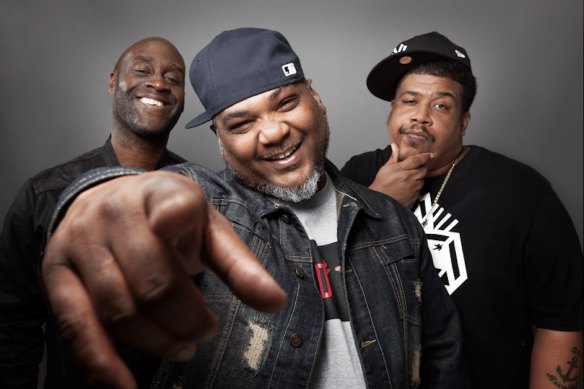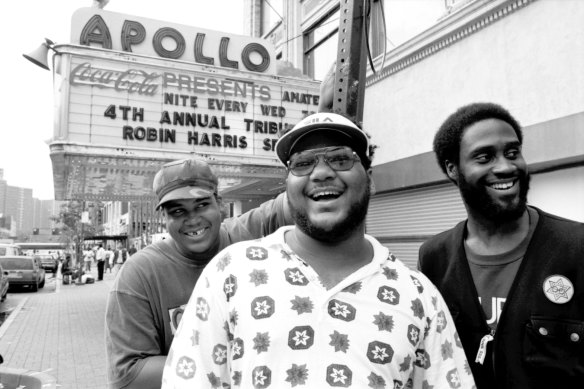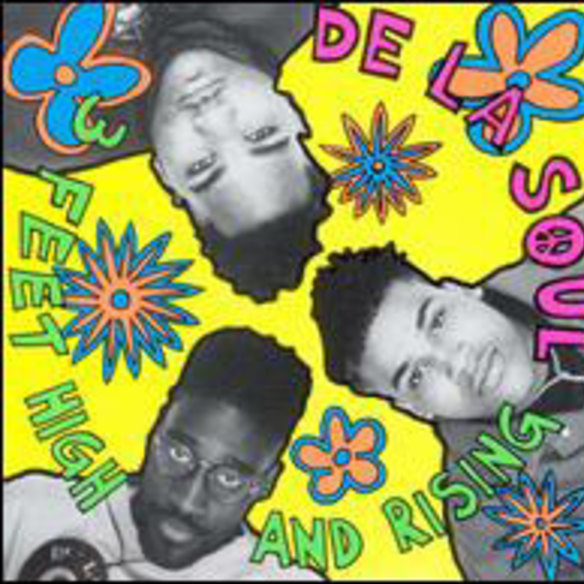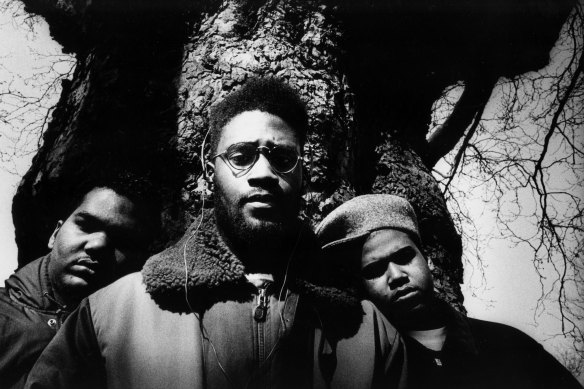Murder, fame and a legal minefield: the agony behind a hip-hop victory

By Michael Dwyer
De La Soul, from left Kelvin ″Posdnous″ Mercer, Vincent ″Maseo″ Mason and ″Trugoy the Dove″ Jolicoeur.
Save articles for later
Add articles to your saved list and come back to them any time.
Vincent “Maseo” Mason’s laugh is legendary. That’s it at the start of Gorillaz’s Feel Good Inc., the monster hit that won De La Soul their first Grammy in 2006. Zooming from his Florida home, the DJ is grinning from one side of his baseball cap to the other.
“It’s all very surreal,” he says, a man released since the New York trio’s 34-year-old masterpiece 3 Feet High and Rising hit worldwide streaming services in March, along with five later De La Soul albums, after a protracted copyright dispute was resolved.
“The fans, of course, are like, ‘Finally!’ But the younger generation, it’s been beautiful to see that. My kids vary from 34 to 23, so that generation right there, watching my kids and their friends, all of them trip out over the music…” He grins some more and shakes his head.
The limbo mostly pertained to copyright claims on samples, those ingeniously reassembled pieces of old records that helped define the golden age of hip-hop. Back in 1991, an opportunistic precedent was set when ’60s pop group the Turtles sued De La Soul for millions of dollars over one 12-second sample.
The chilling effect would essentially change the way hip-hop albums were made. But for the trailblazers, a complex digital clearance stalemate would persist until their old label, Tommy Boy, was acquired by the larger music rights company Reservoir Media in 2021.
From left, “Trugoy the Dove” Jolicoeur, Vincent “Maseo” Mason and Kelvin “Posdnuos” Mercer outside the famed Apollo Theater in Harlem in September 1993.Credit:Getty Images
“It feels good after all these years of feeling erased from history, almost,” Mason says.
But the celebrations are mixed with sadness about the death of De La Soul rapper Dave “Trugoy the Dove” Jolicoeur in February, following years of heart issues. “It’s been hard to celebrate ’cause I lost my boy,” Mason says. “I guess I want to get that up front, to get it over with.”
Jolicoeur’s death was a body blow for Mason and fellow band member Kelvin “Posdnous” Mercer. The threesome had been brothers in music since Amityville Memorial High School on Long Island in the 1980s.
“I’m still processing it now,” Mason says. “It’s still very fresh. You know, every day is a trying day, thinking about him, thinking about all the plans and what we intended to do. Our biggest celebration with one another is on stage. So missing that part with him is … really tough.”
Three was the magic number for De La Soul from the first track of that 1989 debut album. The fresh faces peeking between cartoon flowers on the LP cover symbolised a brighter, more liberated wave for hip-hop when much of its traction was coming from the rage of dispossession: Public Enemy on the east coast, LA gangstas NWA and Ice-T to the west.
The cover of 3 Feet High and Rising symbolised a brighter, more liberated wave for hip-hop.Credit:
In the middle-class suburb of Amityville, “it was still in its embryonic stages of everybody just wanting to do it, and be a part of it, whether it was graffiti, dressing a certain way, rapping or beatboxing, DJing, whatever role you can play in it, just to be ready for a party,” Mason says of De La Soul’s origins.
“It was a childhood hobby for the most part. As far as it becoming a profession, that definitely seemed so far-fetched because it was still new. And it was only a handful of artists that was actually successful. There were so many that were doing it on an independent level, a couple of records here and there … you had to be a part of it to know, you know?”
Today, household names such as Jay-Z, Drake, Kanye West, Lil Wayne, Eminem and Nicki Minaj account for billions upon billions of streams, but there was a time when hip-hop records were “expected to sell 50,000 max – and we superseded that tremendously,” Mason notes of that first album. It shifted millions. Today it’s enshrined in the National Recording Registry of the US Library of Congress, a mark of its “cultural significance and general excellence”.
Creatively, success gave the trio freedom to evolve from the simplistic neo-flower-power niche invented by the ’90s pop media. De La Soul is Dead (1991) sustained the comic tone of its predecessor but there was a maturing perspective that continued to evolve.
“Yeah, we were talking about the state of affairs of what’s happening to hip-hop and the direction that it’s going in,” Mason says of album four especially, Stakes Is High. “And look where it’s at. We got more dead [artists] in our genre than any other genre that exists. And you got to ask yourself why.”
“The records that we made were based on where we were at in each moment,” says Vincent “Maseo” Mason of De La Soul.Credit:Getty Images
According to a 2015 University of Sydney study of death rates among pop musicians, homicide is the cause of death for 51 per cent of deaths in rap/hip-hop artists: five to 30 times higher than other genres surveyed.
As one who came from a less fraught social background than many, Mason has a strong view about what needs to change.
“The pursuit of great wealth has obviously been achievable in this genre. Sustainability of life, that’s what’s been difficult. People being able to live long enough to enjoy the things they achieved. Biggie Smalls, Tupac, Pop Smoke and Nipsey Hussle…” He could name dozens more rappers gunned down in the US these last three decades.
“This is a viable sound that’s become a significant part of pop culture. It’s an evolution of sound and a genre no different than rock and roll … but it comes out of a certain place of struggle and oppression that has a lot of high crime, a lot of poor people, a social environment that has a lot of distress.
“Most of these artists, when they have success, a lot of them like to go back to their neighbourhoods. There’s some coaching that needs to take place so they can protect themselves. Because when you go around a distressed community, somebody’s going to get hurt over all this wealth … It’s just a fact. I don’t care if it’s a black or white community, Italian or African or somewhere in Afghanistan.”
He’s careful “not to disrespect anybody,” but he wonders aloud why the positive political activism of Chicago’s Chance the Rapper, for instance, is such an apparent exception to the prevailing narrative of hip-hop.
“Granted, what is out there is inspiring to those who come from certain communities,” he says. “And I’m not saying what they’re doing is bad creatively. It all holds weight. A lot of these [rappers’] stories are real; very real.
“Unfortunately, what has taken place throughout the ’90s and up has been a system that’s been developed to create an imbalance in the genre to pretty much destroy it. You know, on a grand scale, it’s a beautiful genre, but it’s been constructed in a way that is genocidal.”
Despite their arrested recorded legacy, De La Soul have remained an evolving force on stage and in the studio.
“The records that we made were based on where we were at in each moment,” Mason says. “I mean, 3 Feet High and Rising was actually developed from ’85 up to ’89. We were kids, you know? Now I’m an adult. I can’t make a record with a 15-year-old state of mind. I have other responsibilities now that play a very big part of how we create music. The blessing is still being able to make it good!”
He laughs that laugh. It’s long and loud.
“You know, we’re executing what we discussed before [Trugoy] passed. We’re doing what we always intended to do, which is continue our legacy as a group, be a part of this culture, maintain our responsibility to this culture.
“Trugoy the Dove” Jolicoeur and Vincent “Maseo” Mason performing in London in 2019.Credit:Getty Images
“We’re happy to be a part of the 50th anniversary of hip-hop [in August]. Hip-hop means so much to us, just based on the era that we come from. We’ve grown from when rappers still had day jobs. So to watch it become what it has become, it’s been beautiful to see and be a part of.
“Also, those who didn’t get to have a lot of mainstream success are catching it now. Because of the pioneers that have been able to fight through this cruel business to sustain, we are in a position to make sure everybody who participated significantly and laid foundation to this thing get their roses. Everybody gets them. Everybody.”
A cultural guide to going out and loving your city. Sign up to our Culture Fix newsletter here.
Most Viewed in Culture
Source: Read Full Article




